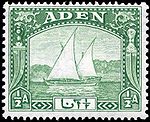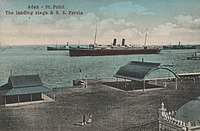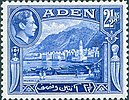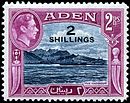Aden
From Wikipedia, the free encyclopedia.
- This article is about the port city of Aden in Yemen. For other uses, see Aden (disambiguation).
Aden (Arabic: عدن [ʿAdan]) is a city in Yemen, 105 miles (170 kilometers) East of Bab-el-Mandeb. It is a natural port, built on an old volcanic peninsula and first used by the ancient Kingdom of Awsan between the 5th and 7th centuries BC. Aden has a population of about 398,399 [1] and is located at 12.779444° N 45.03667° E.
Aden consists of a number of small towns: the port city, the industrial city known as Little Aden with its large oil refinery, and Madinat ash-Sha'b, the centre of government. Two suburbs, Khormaksar and Sheikh Othman, lie north of the old city, with the international airport situated between them. The oil refinery and Tanker port of Little Aden were operated by British Petroleum (now Beyond Petroleum)
It was the capital of the People's Democratic Republic of Yemen until that country's unification with the Yemen Arab Republic when it was declared a free trade zone. It gives its name to the Gulf of Aden.
Contents |
History
Main article: History of Yemen
The port's convenient position on the sea route between India and Europe has made Aden desirable to rulers who sought to possess it at various times throughout history. Known as Arabian Eudaemon in the 1st century BC, it was a transshipping point for the Red Sea trade, but fell on hard times when new shipping practices by-passed it and made the daring direct crossing to India in the 1st century AD, according to the Periplus of the Erythraean Sea.
British Rule
On 19 January 1839 the British East India Company landed Royal Marines at Aden to stop attacks by pirates against British shipping to India. The port lies about equidistant from the Suez canal, Bombay, and Zanzibar, which were all important former British possessions. Aden was to remain under British control until 1967.
Aden was ruled as part of British India until 1937, when it became the Colony of Aden, a British crown colony. The hinterland of Aden and Hadhramaut were also tied to Britain as the Aden Protectorate which was overseen from Aden.

Aden's location also made it a popular exchange port for mail passing between places around the Indian Ocean and Europe. Mail is known to exist from June 15, 1839, although a regular postmaster was not appointed until 1857. Aden used postage stamps of British India until it became a crown colony on April 1, 1937. Although these stamps carried no special identification they may be recognised through the use of the number 124 in postal cancellations, which was assigned to Aden as part of the Indian postal number system. Once Aden became a crown colony it received a series of pictorial stamps inscribed "Aden".
In 1939, a new issue of stamps included a portrait of King George VI, but the sultans in Hadhramaut (whose territories had been under the British Aden Protectorate since the 1880s) objected to this, and so the British government issued separate stamps in 1942, but with the additional inscriptions Kathiri State of Seiyun and Qu'aiti State of Shihr and Mukalla (later Qu'aiti State in Hadhramaut), plus portraits of the respective sultans. All of these types were valid in Aden and the Aden Protectorate.
After the loss of the Suez Canal in 1956, Aden became the main base in the region for the British.
Aden sent a team of two to the 1962 Commonwealth Games in Perth, Western Australia.
Little Aden 1955 to 1967
Little Aden is still dominated by the oil refinery built for British Petroleum. Little Aden was well known to seafarers for its tanker port with a very welcome seaman's mission near to the BP Aden tugs' jetties, complete with swimming pool and air conditioned bar. The accommodation areas for the refinery personnel were known by the original Arabic names of Bureika and Ghadir.
Bureika was wooden housing bunkhouses built to accommodate the thousands of skilled men and labourers imported to build the refinery, later converted to family housing, plus imported prefabricated houses "the Riley-Newsums" that are also to be found in parts of Australia (Woomera). Bureika also had a protected bathing area and Beach Club.
Ghaddir housing was stone built, largely from the local granite quarry; much of this housing still stands today, now occupied by wealthier locals from Big Aden. Little Aden also has a local township and numerous picturesque fishing villages, including the Lobster Pots of Ghaddir. The army had extensive camps in Bureika and through Silent Valley in Falaise Camp, these successfully protected the refinery staff and facilities throughout the troubles, with only a very few exceptions. Schooling was provided for children from kindergarten age through to primary school, after that children were bussed to The Isthmus School in Khormaksar, though this had to be stopped during the Aden Emergency.
Federation of South Arabia and the Aden Emergency
See also: History of Yemen
In order to stabilize Aden and the surrounding Aden Protectorate from the designs of North Yemen, the British attempted to gradually unite the disparate states of the region in preparation for eventual independence. On 18 January 1963, the Colony of Aden was incorporated into the Federation of Arab Emirates of the South against the wishes of much of the city's populace as the State of Aden and the Federation was renamed the Federation of South Arabia (FSA).
An insurgency against British rule known as the Aden Emergency began with a grenade attack by the National Liberation Front (NLF) against the British High Commissioner on December 10, 1963, killing one person and injuring fifty, and a "state of emergency" was declared.
In 1964, Britain announced its intention to granting independence to the FSA in 1968, but that the British military would remain in Aden.
In January 1967, there were mass riots by the NLF and the rival Front for the Liberation of Occupied South Yemen (FLOSY) supporters in the old Arab quarter of Aden town, which continued until mid February, despite the intervention of British troops. During the period there were many attacks on the troops, and an Aden Airlines DC3 plane was destroyed in the air with no survivors.
On November 30, 1967 the British finally pulled out, leaving Aden and the rest of the FSA under NLF control. The Royal Marines, who had been the first British troops to occupy Aden in 1839, were the last to leave.
Independence
Aden became the capital of the new People's Republic of South Yemen which was renamed the People's Democratic Republic of Yemen in 1970. With the unification of northern and southern Yemen in 1990, Aden was no longer a national capital but remained the capital of Aden Governorate which covered an area similar to that of the Aden Colony.
On December 29, 1992 Al Qaeda conducted its first known terrorist attack in an Aden bombing a hotel where US servicemen were known to have stayed. Two Austrian tourists were killed.[2]
Aden was briefly the center of the secessionist Democratic Republic of Yemen from 21 May 1994 but was reoccupied by Republic of Yemen troops on 7 July 1994.
Members of a terrorist group Al Qaeda attempted to bomb USS The Sullivans at the port of Aden as part of the 2000 millennium attack plots. The boat that had the explosives in it sank, forcing the aborting of the planned attack.
The USS Cole bombing occurred in Aden on 12 October 2000.






